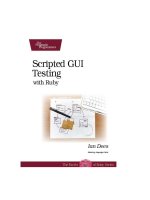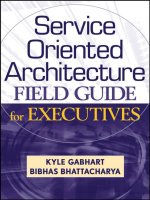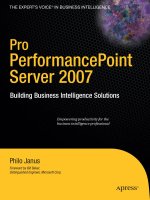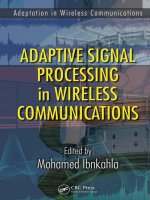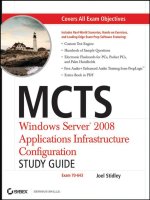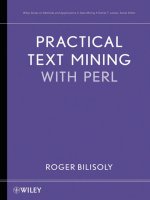Wiley practical text mining with perl aug 2008 ISBN 0470176431 pdf
Bạn đang xem bản rút gọn của tài liệu. Xem và tải ngay bản đầy đủ của tài liệu tại đây (17.57 MB, 322 trang )
Practical Text Mining
With Per1
Roger Bilisoly
Department of Mathematical Sciences
Central Connecticut State University
WILEY
A JOHN WILEY & SONS, INC., PUBLICATION
Practical Text Mining
With Per1
WILEY SERIES ON METHODS AND APPLICATIONS
IN DATA MINING
Series Editor: Daniel T. Larose
Discovering Knowledge in Data: An Introduction to Data Mining Daniel T. LaRose
Data-Mining on the Web: Uncovering Patterns in Web Content, Structure, and Usage Zdravko
Markov and Daniel Larose
Data Mining Methods and Models
Daniel Larose
Practical Text Mining with Per1 Roger Bilisoly
Practical Text Mining
With Per1
Roger Bilisoly
Department of Mathematical Sciences
Central Connecticut State University
WILEY
A JOHN WILEY & SONS, INC., PUBLICATION
Copyright 0 2008 by John Wiley & Sons, Inc. All rights reserved.
Published by John Wiley & Sons, Inc., Hoboken, New Jersey
Published simultaneously in Canada.
No part of this publication may be reproduced, stored in a retrieval system, or transmitted in any form or by
any means, electronic, mechanical, photocopying, recording, scanning, or otherwise, except as permitted under
Section 107 or 108 of the 1976 United States Copyright Act, without either the prior written permission of the
Publisher, or authorization through payment of the appropriate per-copy fee to the Copyright Clearance Center,
Inc., 222 Rosewood Drive, Danvers, MA 01923, (978) 750-8400, fax (978) 750-4470, or on the web at
www.copyright.com. Requests to the Publisher for permission should be addressed to the Permissions
Department, John Wiley & Sons, Inc., 11 1 River Street, Hoboken, NJ 07030, (201) 748-601 1, fax (201) 7486008, or online at http:llwww.wiley.com/go/permission.
Limit of Liability/Disclaimer of Warranty: While the publisher and author have used their best efforts in
preparing this book, they make no representations or warranties with respect to the accuracy or completeness of
the contents of this book and specifically disclaim any implied warranties of merchantability or fitness for a
particular purpose. No warranty may be created or extended by sales representatives or written sales materials.
The advice and strategies contained herein may not be suitable for your situation. You should consult with a
professional where appropriate. Neither the publisher nor author shall be liable for any loss of profit or any
other commercial damages, including but not limited to special, incidental, consequential, or other damages.
For general information on our other products and services or for technical support, please contact our
Customer Care Department within the United States at (800) 762-2974, outside the United States at (317) 5723993 or fax (317) 572-4002.
Wiley also publishes its books in a variety of electronic formats. Some content that appears in print may not be
available in electronic format. For information about Wiley products, visit our web site at www.wiley.com.
Library of Congress Cataloging-in-Publication Data:
Bilisoly, Roger, 1963Practical text mining with Per1 J Roger Bilisoly
p. cm.
Includes bibliographical references and index.
ISBN 978-0-470-17643-6 (Cloth)
1. Data mining. 2. Text processing (Computer science) 3. Per1 (Computer program language) I. Title.
QA76.9.D343.B45 2008
005.746~22
2008008144
Printed in the United States of America.
1 0 9 8 7 6 5 4 3 2 1
To my Mom and Dad & all
their cats.
This Page Intentionally Left Blank
Contents
...
List of Figures
Xlll
List of Tables
xv
Preface
xvii
Acknowledgments
xxiii
1
Introduction
1.1
1.2
1.3
Overview of this Book
Text Mining and Related Fields
1.2.1 Chapter 2: Pattern Matching
1.2.2 Chapter 3: Data Structures
1.2.3 Chapter 4: Probability
1.2.4 Chapter 5: Information Retrieval
1.2.5 Chapter 6: Corpus Linguistics
1.2.6 Chapter 7: Multivariate Statistics
1.2.7 Chapter 8: Clustering
1.2.8 Chapter 9: Three Additional Topics
Advice for Reading this Book
1
1
2
2
3
3
3
4
4
5
5
5
vii
viii
2
CONTENTS
Text Patterns
2.1
2.2
2.3
2.4
2.5
2.6
2.7
2.8
3
Introduction
Regular Expressions
2.2.1 First Regex: Finding the Word Cat
2.2.2 Character Ranges and Finding Telephone Numbers
2.2.3 Testing Regexes with Perl
Finding Words in a Text
2.3.1 Regex Summary
2.3.2 Nineteenth-Century Literature
2.3.3 Perl Variables and the Function s p l i t
2.3.4 Match Variables
Decomposing Poe’s “The Tell-Tale Heart” into Words
2.4.1
Dashes and String Substitutions
2.4.2 Hyphens
2.4.3 Apostrophes
A Simple Concordance
2.5.1
Command Line Arguments
2.5.2 Writing to Files
First Attempt at Extracting Sentences
2.6.1 Sentence Segmentation Preliminaries
2.6.2 Sentence Segmentation for A Christmas Carol
2.6.3 Leftmost Greediness and Sentence Segmentation
Regex Odds and Ends
2.7.1 Match Variables and Backreferences
2.7.2 Regular Expression Operators and Their Output
2.7.3 Lookaround
References
Problems
Quantitative Text Summaries
3.1
3.2
3.3
3.4
3.5
3.6
3.7
Introduction
Scalars, Interpolation, and Context in Perl
Arrays and Context in Perl
Word Lengths in Poe’s “The Tell-Tale Heart”
Arrays and Functions
3.5.1 Adding and Removing Entries from Arrays
3.5.2 Selecting Subsets of an Array
3.5.3 Sorting an Array
Hashes
3.6.1
Using a Hash
TWO Text Applications
7
7
8
8
10
12
15
15
17
17
20
21
23
24
27
28
33
33
34
35
37
41
46
47
48
50
52
52
59
59
59
60
64
66
66
69
69
73
74
77
CONTENTS
3.8
3.9
3.10
3.7.1 Zipf’s Law for A Christmas Carol
3.7.2 Perl for Word Games
3.7.2.1
An Aid to Crossword Puzzles
Word Anagrams
3.7.2.2
3.1.2.3
Finding Words in a Set of Letters
Complex Data Structures
3.8.1 References and Pointers
3.8.2 Arrays of Arrays and Beyond
3.8.3 Application: Comparing the Words in Two Poe Stories
References
First Transition
Problems
ix
77
83
83
84
85
86
87
90
92
96
97
97
Probability and Text Sampling
105
4.1
4.2
105
105
106
108
109
112
115
117
118
120
123
124
124
128
129
4.3
4.4
4.5
4.6
4.7
Introduction
Probability
4.2.1
Probability and Coin Flipping
4.2.2 Probabilities and Texts
Estimating Letter Probabilities for Poe and Dickens
4.2.2.1
4.2.2.2
Estimating Letter Bigram Probabilities
Conditional Probability
4.3.1 Independence
Mean and Variance of Random Variables
4.4.1
Sampling and Error Estimates
The Bag-of-Words Model for Poe’s “The Black Cat“
The Effect of Sample Size
4.6.1 Tokens vs. Types in Poe’s “Hans Pfaall”
References
Problems
Applying Information Retrieval t a Text Mining
133
5.1
5.2
133
134
134
136
138
139
140
140
143
143
5.3
5.4
Introduction
Counting Letters and Words
5.2.1 Counting Letters in Poe with Perl
5.2.2 Counting Pronouns Occurring in Poe
Text Counts and Vectors
5.3.1 Vectors and Angles for Two Poe Stories
5.3.2 Computing Angles between Vectors
5.3.2.1
Subroutines in Perl
5.3.2.2
Computing the Angle between Vectors
The Term-Document Matrix Applied to Poe
CONTENTS
5.5
5.6
5.7
5.8
Matrix Multiplication
5.5.1 Matrix Multiplication Applied to Poe
Functions of Counts
Document Similarity
5.7.1 Inverse Document Frequency
5.7.2 Poe Story Angles Revisited
References
Problems
Concordance Lines and Corpus Linguistics
6.1
6.2
6.3
6.4
6.5
6.6
6.7
Introduction
Sampling
6.2.1 Statistical Survey Sampling
6.2.2 Text Sampling
Corpus as Baseline
6.3.1 Function vs. Content Words in Dickens, London, and Shelley
Concordancing
6.4.1
Sorting Concordance Lines
Code for Sorting Concordance Lines
6.4.1.1
6.4.2 Application: Word Usage Differences between London and
Shelley
6.4.3 Application: Word Morphology of Adverbs
Collocations and Concordance Lines
6.5.1 More Ways to Sort Concordance Lines
6.5.2 Application: Phrasal Verbs in The Call of the Wild
6.5.3 Grouping Words: Colors in The Call of the Wild
Applications with References
Second Transition
Problems
147
148
150
152
153
154
157
157
161
161
162
162
163
164
168
169
170
171
172
176
179
179
181
184
185
187
188
MultivariateTechniques with Text
191
7.1
7.2
191
192
193
195
199
20 1
202
202
205
206
7.3
7.4
Introduction
Basic Statistics
7.2.1 z-Scores Applied to Poe
7.2.2 Word Correlations among Poe’s Short Stories
7.2.3 Correlations and Cosines
7.2.4
Correlations and Covariances
Basic linear algebra
7.3.1 2 by 2 Correlation Matrices
Principal Components Analysis
7.4.1 Finding the Principal Components
CONTENTS
7.5
7.6
8
206
209
209
21 1
21 1
21 1
212
Text Clustering
219
8.1
8.2
219
220
220
223
224
229
230
234
235
235
236
236
236
8.3
8.4
8.5
9
7.4.2 PCA Applied to the 68 Poe Short Stories
7.4.3 Another PCA Example with Poe’s Short Stories
7.4.4 Rotations
Text Applications
7.5.1 A Word on Factor Analysis
Applications and References
Problems
xi
Introduction
Clustering
8.2.1 Two-Variable Example of k-Means
8.2.2 k-Means with R
8.2.3 He versus She in Poe’s Short Stories
8.2.4 Poe Clusters Using Eight Pronouns
8.2.5 Clustering Poe Using Principal Components
8.2.6 Hierarchical Clustering of Poe’s Short Stories
A Note on Classification
8.3.1 Decision Trees and Overfitting
References
Last Transition
Problems
A Sample of Additional Topics
9.1
9.2
9.3
9.4
9.5
Introduction
Perl Modules
9.2.1 Modules for Number Words
9.2.2 The StopWords Module
9.2.3 The Sentence Segmentation Module
9.2.4 An Object-Oriented Module for Tagging
9.2.5
Miscellaneous Modules
Other Languages: Analyzing Goethe in German
Permutation Tests
9.4.1
Runs and Hypothesis Testing
9.4.2 Distribution of Character Names in Dickens and London
References
Appendix A: Overview of Perl for Text Mining
A.1
Basic Data Structures
A. 1.1 Special Variables and Arrays
A.2 Operators
243
243
243
244
245
245
247
248
248
25 1
252
254
258
259
259
262
263
xii
CONTENTS
A.3
A.4
A.5
Branching and Looping
A Few Per1 Functions
Introduction to Regular Expressions
266
270
27 1
Appendix B: Summary of R used in this Book
B. 1 Basics of R
B.l.l
Data Entry
B.1.2 Basic Operators
B.1.3 Matrix Manipulation
B.2 This Book’s R Code
275
275
276
277
278
279
References
283
Index
29 1
List of Figures
3.1
Log(Frequency) vs. Log(Rank) for the words in Dickens’s A Christmas
Carol.
84
4.1
Plot of the running estimate of the probability of heads for 50 flips.
109
4.2
Plot of the running estimate of the probability of heads for 5000 flips.
110
4.3
Histogram of the proportions of the letter e in 68 Poe short stones based
on table 4.1,
120
4.4
4.5
4.6
4.7
Histogram and best fitting normal curve for the proportions of the letter
e in 68 Poe short stories.
122
Plot of the number of types versus the number of tokens for “The
Unparalleled Adventures of One Hans Pfaall.” Data is from program 4.5.
Figure adapted from figure 1.1 of Baayen [6] with kind permission
from Springer Science and Business Media and the author.
126
Plot of the mean word frequency against the number of tokens for
“The Unparalleled Adventures of One Hans Pfaall.” Data is from
program 4.5. Figure adapted from figure 1.1 of Baayen [6] with kind
permission from Springer Science and Business Media and the author.
127
Plot of the mean word frequency against the number of tokens for “The
Unparalleled Adventures of One Hans Pfaall“ and “The Black Cat.”
Figure adapted from figure 1.1 of Baayen [6] with kind permission
from Springer Science and Business Media and the author.
128
xiii
xiv
LIST OF FIGURES
The vector (4,3) makes a right triangle if a line segment perpendicular
to the x-axis is drawn to the x-axis.
141
Comparing the frequencies of the word the (on the x-axis) against city
(on the y-axis). Note that the y-axis is not to scale: it should be more
compressed.
151
Comparing the logarithms of the frequencies for the words the (on the
x-axis) and city (on the y-axis).
152
7.1
Plotting pairs of word counts for the 68 Poe short stories.
198
7.2
Plots of the word counts for the versus of using the 68 Poe short stories. 199
8.1
A two variable data set that has two obvious clusters.
220
8.2
The perpendicular bisector of the line segment from (0,l) to (1,l)
divides this plot into two half-planes. The points in each form the two
clusters.
22 1
The next iteration of k-means after figure 8.2. The line splits the data
into two groups, and the two centroids are given by the asterisks.
222
8.4
Scatterplot of heRate against sheRate for Poe’s 68 short stories.
226
8.5
Plot of two short story clusters fitted to the heRate and sheRate data.
227
8.6
Plots of three, four, five, and six short story clusters fitted to the heRate
and sheRate data.
228
Plots of two short story clusters based on eight variables, but only
plotted for the two variables heRate and sheRate.
230
Four more plots showing projections of the two short story clusters
found in output 8.7 onto two pronoun rate axes.
23 1
Eight principal components split into two short story clusters and
projected onto the first two PCs.
233
A portion of the dendrogram computed in output 8.1 1, which shows
hierarchical clusters for Poe’s 68 short stories.
234
8.11
The plot of the Voronoi diagram computed in output 8.12.
238
8.12
All four plots have uniform marginal distributions for both the x and
y-axes. For problem 8.4.
240
The dendrogram for the distances between pronouns based on Poe’s 68
short stories. For problem 8.5.
24 1
Histogram of the numbers of runs in 100,000 random permutations of
digits in equation 9.1.
254
5.1
5.2
5.3
8.3
8.7
8.8
8.9
8.10
8.13
9.1
9.2
Histogram of the runs of the 10,000 permutations of the names Scrooge
256
and Marley as they appear in A Christmas Carol.
9.3
Histogram of the runs of the 10,000 permutations of the names Francois
and Perrault as thev amear in The Call of the Wild.
257
List of Tables
2.1
Telephone number formats we wish to find with a regex. Here d stands
for a digit 0 through 9.
11
2.2
Telephone number input to test regular expression 2.2.
14
2.3
Summary of some of the special characters used by regular expressions
with examples of strings that match.
16
2.4
Removing punctuation: a sample of five mistakes made by program 2.4.
23
2.5
Some values of the Perl variable $/ and their effects.
31
2.6
A variety of ways of combining two short sentences.
35
2.7
Sentence segmentation by program 2.8 fails for this sentence.
46
2.8
Defining true and false in Perl.
48
3.1
Comparison of arrays and hashes in Perl.
73
4.1
Proportions of the letter e for 68 Poe short stories, sorted smallest to
largest.
119
Two intervals for the proportion of e’s in Poe’s short stories using
table 4.1.
121
Counts of four-letter words satisfying each pair of conditions. For
problem 4.5.
130
4.2
4.3
xv
xvi
CONTENTS
5.1
Character counts for four Poe stories combined. Computed by
program 5.1.
134
5.2
Pronoun counts from program 5.2 and code sample 5.1 for 4 Poe stories. 144
6.1
Character counts for the EnronSent email corpus.
165
6.2
Twenty most frequent words in the EnronSent email corpus, Dickens’s
A Christmas Carol, London’s The Call of the Wild, and Shelley’s
Frankenstein using code sample 6.1.
168
6.3
Eight phrasal verbs using the preposition up.
169
6.4
First 10 lines containing the word body in The Call of the Wild.
175
6.5
First 10 lines containing the word body in Frankenstein.
175
9.1
Letter frequencies of Dickens’s A Christmas Carol, Poe’s “The Black
Cat,” and Goethe’s Die Leiden des jungen Werthers.
249
Inflected forms of the word the in Goethe’s Die Leiden des jungen
Werthers.
25 1
Counts of the six forms of the German word for the in Goethe’s Die
Leiden des jungen Werthers.
25 1
A. 1
A few special variables and their use in Perl.
263
A.2
String functions in Perl with examples.
270
A.3
Array functions in Perl with examples.
27 1
A.4
Hash functions in Perl with examples
27 1
AS
Some special characters used in regexes as implemented in Perl.
273
A.6
Repetition syntax in regexes as implemented in Perl.
273
B.l
Data in the file test. csv.
276
B.2
R functions used with matrices.
280
B.3
R functions for statistical analyses.
28 1
B .4
R functions for graphics.
28 1
B.5
Miscellaneous R functions.
282
9.2
9.3
Preface
What This Book Covers
This book introduces the basic ideas of text mining, which is a group of techniques that
extracts useful information from one or more texts. This is a practical book, one that focuses
on applications and examples. Although some statistics and mathematics is required, it is
kept to a minimum, and what is used is explained.
This book, however, does make one demand: it assumes that you are willing to learn
to write simple programs using Perl. This programming language is explicitly designed to
work with text. In addition, it is open-source software that is available over the Web for
free. That is, you can download the latest full-featured version of Perl right now, and install
it on all the computers you want without paying a cent.
Chapters 2 and 3 give the basics of Perl, including a detailed introduction to regular
expressions, which is a text pattern matching methodology used in a variety of programming
languages, not just Perl. For each concept there are several examples of how to use it to
analyze texts. Initial examples analyze short strings, for example, a few words or a sentence.
Later examples use text from a variety of literary works, for example, the short stories of
Edgar Allan Poe, Charles Dickens’s A Christmas Carol, Jack London’s The Call of the Wild,
and Mary Shelley’s Frankenstein. All the texts used here are part of the public domain, so
you can download these for free, too. Finally, if you are interested in word games, Perl plus
extensive word lists are a great combination, which is covered in chapter 3.
Chapters 4 through 8 each introduce a core idea used in text mining. For example,
chapter 4 explains the basics of probability, and chapter 5 discusses the term-document
matrix, which is an important tool from information retrieval.
xvii
xviii
PREFACE
This book assumes that you want to analyze one or more texts, so the focus is on the
practical. All the techniques in this book have immediate applications. Moreover, learning
a minimal amount of Perl enables you to modify the code in this book to analyze the texts
that interest you.
The level of mathematical knowledge assumed is minimal: you need to know how to
count. Mathematics that arises for text applications is explained as needed and is kept to
the minimum to do the job at hand. Although most of the techniques used in this book were
created by researchers knowledgeable in math, a few basic ideas are all that are needed to
read this book.
Although I am a statistician by training, the level of statistical knowledge assumed is
also minimal. The core tools of statistics, for example, variability and correlations, are
explained. It turns out that a few techniques are applicable in many ways.
The level of prior programming experience assumed is again minimal: Perl is explained
from the beginning, and the focus is on working with text. The emphasis is on creating
short programs that do a specific task, not general-purpose text mining tools. However, it is
assumed that you are willing to put effort into learning Perl. If you have never programmed
in any computer language at all, then doing this is a challenge. Nonetheless, the payoff is
big if you rise to this challenge.
Finally, all the code, output, and figures in this book are produced with software that
is available from the Web at no cost to you, which is also true of all the texts analyzed.
Consequently, you can work through all the computer examples with no additional costs.
What Is Text Mining?
The text in text mining refers to written language that has some informational content.
For example, newspaper stories, magazine articles, fiction and nonfiction books, manuals,
blogs, email, and online articles are all texts. The amount of text that exists today is vast,
and it is ever growing.
Although there are numerous techniques and approaches to text mining, the overall goal
is simple: it discovers new and useful information that is contained in one or more text
documents. In practice, text mining is done by running computer programs that read in
documents and process them in a variety of ways. The results are then interpreted by
humans.
Text mining combines the expertise of several disciplines: mathematics, statistics, probability, artificial intelligence, information retrieval, and databases, among others. Some of
its methods are conceptually simple, for example, concordancing where all instances of
a word are listed in its context (like a Bible concordance). There are also sophisticated
algorithms such as hidden Markov models (used for identifying parts of speech). This book
focuses on the simpler techniques. However, these are useful and practical nonetheless,
and serve as a good introduction to more advanced text mining books.
This Book’s Approach toText Mining
This book has three broad themes. First, text mining is built upon counting and text pattern
matching. Second, although language is complex, some aspects of it can be studied by
considering its simpler properties. Third, combining computer and human strengths is a
powerful way to study language. We briefly consider each of these.
PREFACE
xix
First, text pattern matching means identifying a pattern of letters in a document. For
example, finding all instances of the word cat requires using a variety of patterns, some of
which are below.
cat Cat cats Cats cat’s Cat’s cats’ cat, cat. cat!
It also requires rejecting words like catastrophe or scatter, which contain the string
cat, but are not otherwise related. Using regular expressions, this can be explained to a
computer, which is not daunted by the prospect of searching through millions of words.
See section 2.2.1 for further discussion of this example and chapter 2 for text patterns in
general.
It turns out that counting the number of matches to a text pattern occurs again and again
in text mining, even in sophisticated techniques. For example, one way to compute the
similarity of two text documents is by counting how many times each word appears in both
documents. Chapter 5 considers this problem in detail.
Second, while it is true that the complexity of language is immense, some information
about language is obtainable by simple techniques. For example, recent language reference
books are often checked against large text collections (called corpora). Language patterns
have been both discovered and verified by examining how words are used in writing and
speech samples. For example, big, large, and great are similar in meaning, but the examination of corpora shows that they are not used interchangeably. For example, the following
sentences: “he has big feet,” “she has large feet,” and “she has great insight“ sound good,
but “he has big insight” or “she has large insight” are less fluent. In this type of analysis, the
computer finds the examples of usage among vast amounts of text, and a human examines
these to discover patterns of meanings. See section 6.4.2 for an example.
Third, as noted above, computers follow directions well, and they are untiring, while
humans are experts at using and interpreting language. However, computers have limited
understanding of language, and humans have limited endurance. These facts suggest an
iterative and collaborative strategy: the results of a program are interpreted by a human
who, in turn, decides what further computer analyses are needed, if any. This back and
forth process is repeated as many times as is necessary. This is analogous to exploratory data
analysis, which exploits the interplay between computer analyses and human understanding
of what the data means.
Why Use Perl?
This section title is really three questions. First, why use Perl as opposed to an existing
text mining package? Second, why use Perl as opposed to other programming languages?
Third, why use Perl instead of so-called pseudo-code? Here are three answers, respectively.
First, if you have a text mining package that can do everything you want with all the texts
that interest you, and if this package works exactly the way you want it, and if you believe
that your future processing needs will be met by this package, then keep using it. However,
it has been my experience that the process of analyzing texts suggests new ideas requiring
new analyses and that the boundaries of existing tools are reached too soon in any package
that does not allow the user to program. So at the very least, I prefer packages that allow
the user to add new features, which requires a programming language. Finally, learning
how to use a package also takes time and effort, so why not invest that time in learning a
flexible tool like Perl.
XX
PREFACE
Second, Perl is a programming language that has text pattern matching (called regular
expressions or regexes), and these are easy to use with a variety of commands. It also has
a vast amount of free add-ons available on the Web, many of which are for text processing.
Additionally, there are numerous books and tutorials and online resources for Perl, so it is
easy to find out how to make it do what you want. Finally, you can get on the Web and
download full-strength Perl right now, for free: no hidden charges!
Larry Wall built Perl as a text processing computer language. Moreover, he studied
linguistics in graduate school, so he is knowledgeable about natural languages, which
influenced his design of Perl. Although many programming languages support text pattern
matching, Perl is designed to make it easy to use this feature.
Third, many books use pseudo-code, which excels at showing the programming logic.
In my experience, this has one big disadvantage. Students without a solid programming
background often find it hard to convert pseudo-code to running code. However, once Perl
is installed on a computer, accurate typing is all that is required to run a program. In fact, one
way to learn programming is by taking existing code and modifying it to see what happens,
and this can only be done with examples written in a specific programming language.
Finally, personally, I enjoy using Perl, and it has helped me finish numerous text processing tasks. It is easy to learn a little Perl and then apply it, which leads to learning more,
and then trying more complex applications. I use Perl for a text mining class I teach at
Central Connecticut State University, and the students generally like the language. Hence,
even if you are unfamiliar with it, you are likely to enjoy applying it to analyzing texts.
Organization of This Book
After an overview of this book in chapter 1, chapter 2 covers regular expressions in detail.
This methodology is quite powerful and useful, and the time spent learning it pays off in
the later chapters. Chapter 3 covers the data structures of Perl. Often a large number of
linguistic items are considered all at once, and to work with all of them requires knowing
how to use arrays and hashes as well as more complex data structures.
With the basics of Perl in hand, chapter 4 introduces probability. This lays the foundation
for the more complex techniques in later chapters, but it also provides an opportunity to
study some of the properties of language. For example, the distribution of the letters of the
alphabet of a Poe story is analyzed in section 4.2.2.1.
Chapter 5 introduces the basics of vectors and arrays. These are put to good use as
term-document matrices, which is a fundamental tool of information retrieval. Because it
is possible to represent a text as a vector, the similarity of two texts can be measured by the
angle between the two vectors representing the texts.
Corpus linguistics is the study of language using large samples of texts. Obviously this
field of knowledge overlaps with text mining, and chapter 6 introduces the fundamental
idea of creating a text concordance. This takes the text pattern matching ability of regular
expressions, and allows a researcher to compare the matches in a variety of ways.
Text can be measured in numerous ways, which produces a data set that has many
variables. Chapter 7 introduces the statistical technique of principal components analysis
(PCA), which is one way to reduce a large set of variables to a smaller, hopefully easier to
interpret, set. PCA is a popular tool among researchers, and this chapter teaches you the
basic idea of how it works.
Given a set of texts, it is often useful to find out if these can be split into groups such
that (1) each group has texts that are similar to each other and (2) texts from two different
PREFACE
xxi
groups are dissimilar. This is called clustering. A related technique is to classify texts into
existing categories, which is called classification. These topics are introduced in chapter 8.
Chapter 9 has three shorter sections, each of which discusses an idea that did not fit in
one of the other chapters. Each of these is illustrated with an example, and each one has
ties to earlier work in this book.
Finally, the first appendix gives an overview of the basics of Perl, while the second
appendix lists the R commands used at the end of chapter 5 as well as chapters 7 and 8. R
is a statistical software package that is also available for free from the Web. This book uses
it for some examples, and references for documentation and tutorials are given so that an
interested reader can learn more about it.
ROGERBILISOLY
New Britain, Connecticut
May 2008
This Page Intentionally Left Blank
Acknowledgments
Thanks to the Department of Mathematical Sciences of Central Connecticut State University (CCSU) for an environment that provided me the time and resources to write this book.
Thanks to Dr. Daniel Larose, Director of the Data Mining Program at CCSU, for encouraging me to develop Stat 527, an introductory course on text mining. He also first suggested
that I write a data mining book, which eventually became this text.
Some of the ideas in chapters 2, 3, and 5 arose as I developed and taught text mining
examples for Stat 527. Thanks to Kathy Albers, Judy Spomer, and Don Wedding for taking
independent studies on text mining, which helped to develop this class. Thanks again to
Judy Spomer for comments on a draft of chapter 2.
Thanks to Gary Buckles and Gina Patacca for their hospitality over the years. In particular, my visits to The Ohio State University’s libraries would have been much less enjoyable
if not for them.
Thanks to Dr. Edward Force for reading the section on text mining German. Thanks
to Dr. Krishna Saha for reading over my R code and giving suggestions for improvement.
Thanks to Dr. Nell Smith and David LaPierre for reading the entire manuscript and making
valuable suggestions on it.
Thanks to Paul Petralia, senior editor at Wiley Interscience who let me write the book
that I wanted to write.
The notation and figures in my section 4.6.1 are based on section 1.1 and figure 1.1
of Word Fequency Distributions by R. Harald Baayen, which is volume 18 of the “Text,
Speech and Language Technology” series, published in 2001. This is possible with the kind
permission of Springer Science and Business Media as well as the author himself.
xxiii


